Welcome to the enchanting world of Begonia Angelique, where being a plant parent becomes a truly magical experience. As a devoted plant enthusiast, the discovery of this little guy brought a burst of joy to my plant-parenting journey.
Get ready to explore the charm and beauty of this extraordinary hybrid bloom.
Key Takeaways
- Unique Hybrid: Begonia Angelique, a delightful hybrid of Begonia aconitifolia and Begonia coccinea, offers a one-of-a-kind botanical experience.
- Elegant Aesthetic: Revel in the beauty of angelic blooms, featuring a palette of blush pinks, rich reds, and creamy whites.
- Versatile Indoors and Outdoors: Whether adorning your garden or enhancing indoor spaces, Begonia Angelique adapts effortlessly to various environments.
- Year-Round Blooms: Experience the joy of perpetual beauty as Begonia Angelique graces your surroundings with blooms throughout the year.
- Low-Maintenance Charm: Discover a plant that effortlessly combines stunning aesthetics with minimal upkeep, making it a favorite among plant parents.
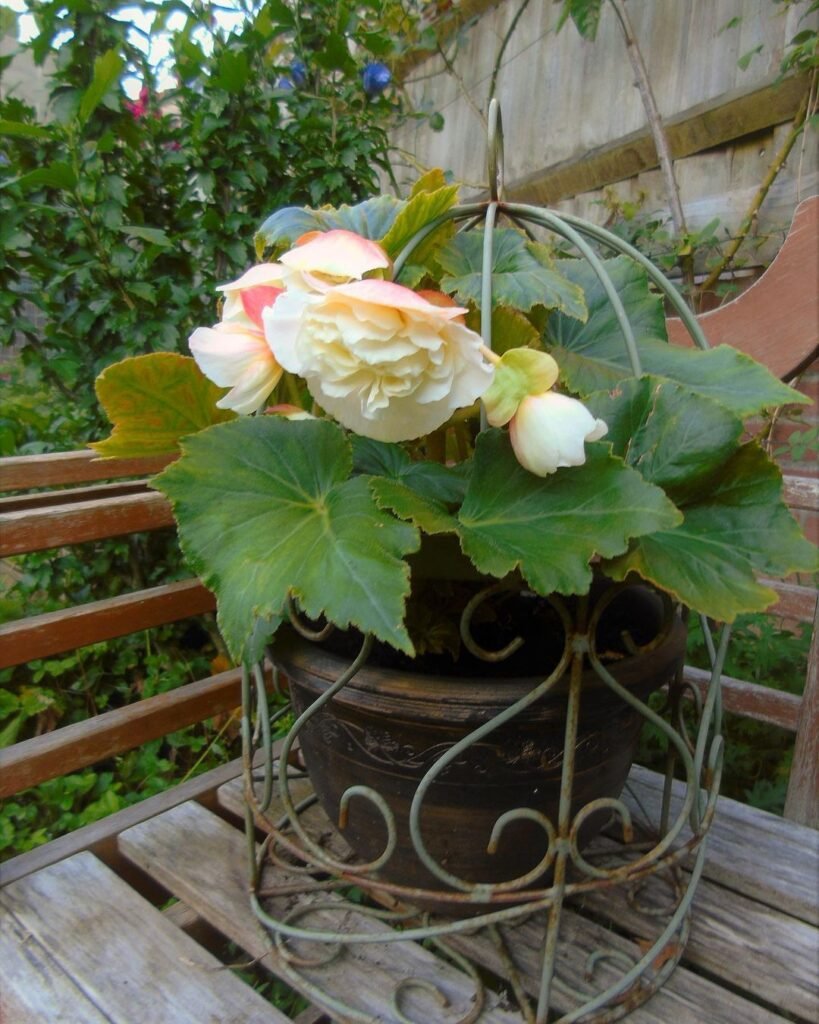
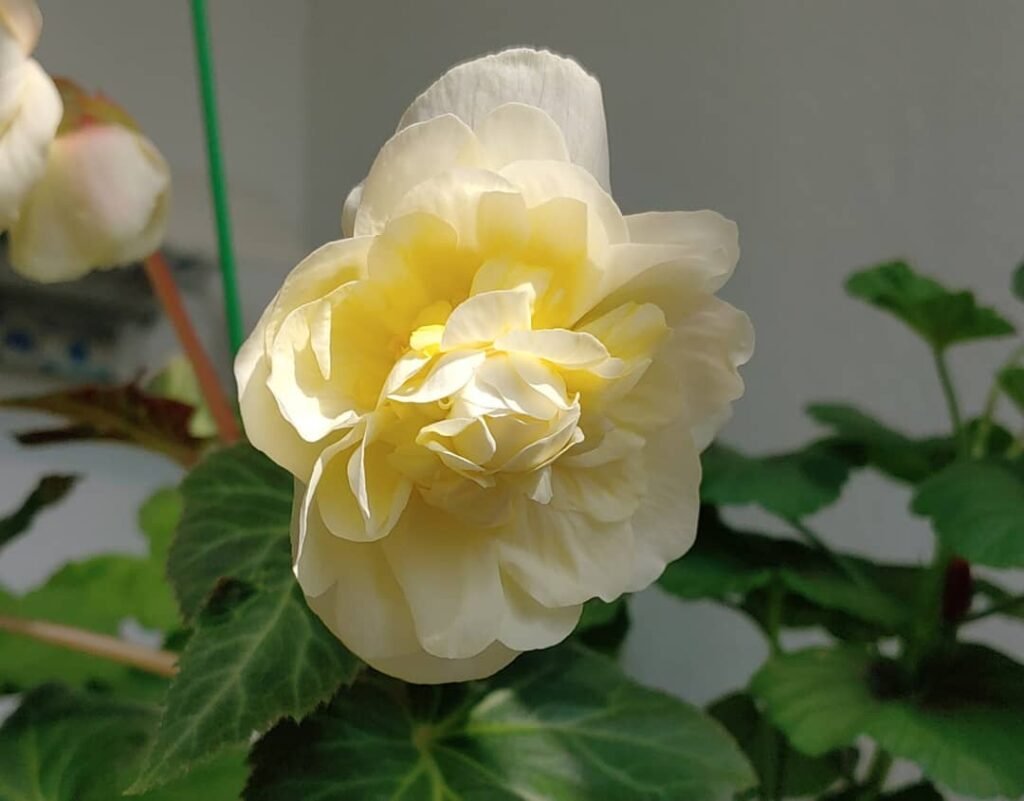

Care Guide Overview
Embarking on a successful Begonia Angelique journey requires a nurturing touch and a keen understanding of its specific needs. Let’s delve into the comprehensive care guide for your botanical companion.
| Care Aspect | Overview |
|---|---|
| 💧 Watering | Begonia Angelique craves consistency. Keep the soil lightly moist and avoid waterlogging. Water when the top inch of soil feels dry. |
| ☀️ Lighting | Provide bright, indirect light for optimal growth. Shield from harsh midday sun, but ensure it receives adequate illumination to fuel its vibrant blooms. |
| 🌱 Soil and Fertilizing | Opt for a well-draining potting mix and fertilize monthly during the growing season. Strike a balance, as Begonia Angelique thrives with a modest but regular nutrient supply. |
| 💦 Humidity and Temperature | Maintain a humid environment by misting regularly. Keep temperatures between 65°F to 75°F (18°C to 24°C). Protect from drafts and sudden temperature fluctuations. |
| ✂️ Pruning and Shaping Tips | Encourage bushy growth by pinching off the tips regularly. Prune dead or yellowing leaves to promote overall plant health and maintain its elegant form. |
| 🌱 Propagation Tips | Expand your Begonia Angelique family through stem cuttings. Ensure the cuttings have at least two leaves and dip them in rooting hormone before planting. |
| 🏺 Repotting Tips | Refresh the soil every 1-2 years and consider repotting when the plant outgrows its current container. Gently handle the roots to avoid stress during the transition. |
Appearance of Begonia Angelique

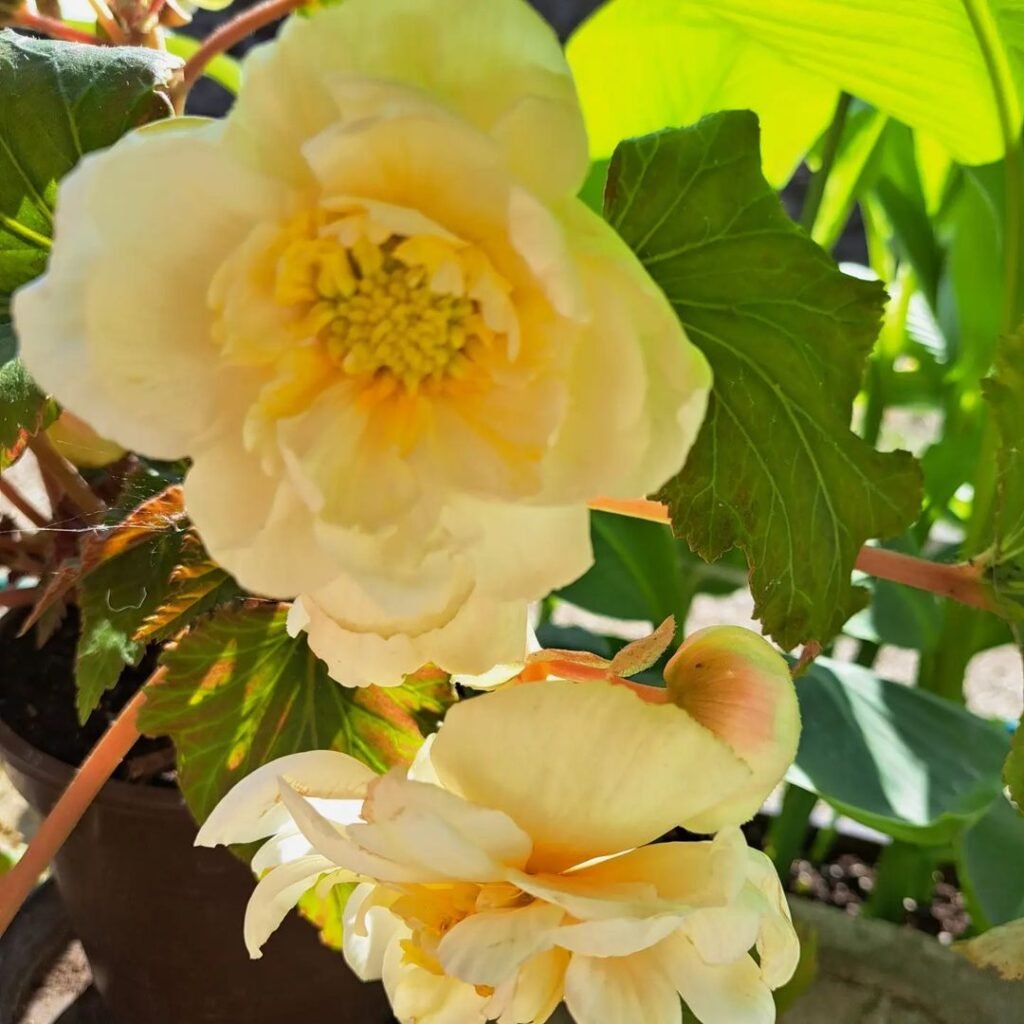
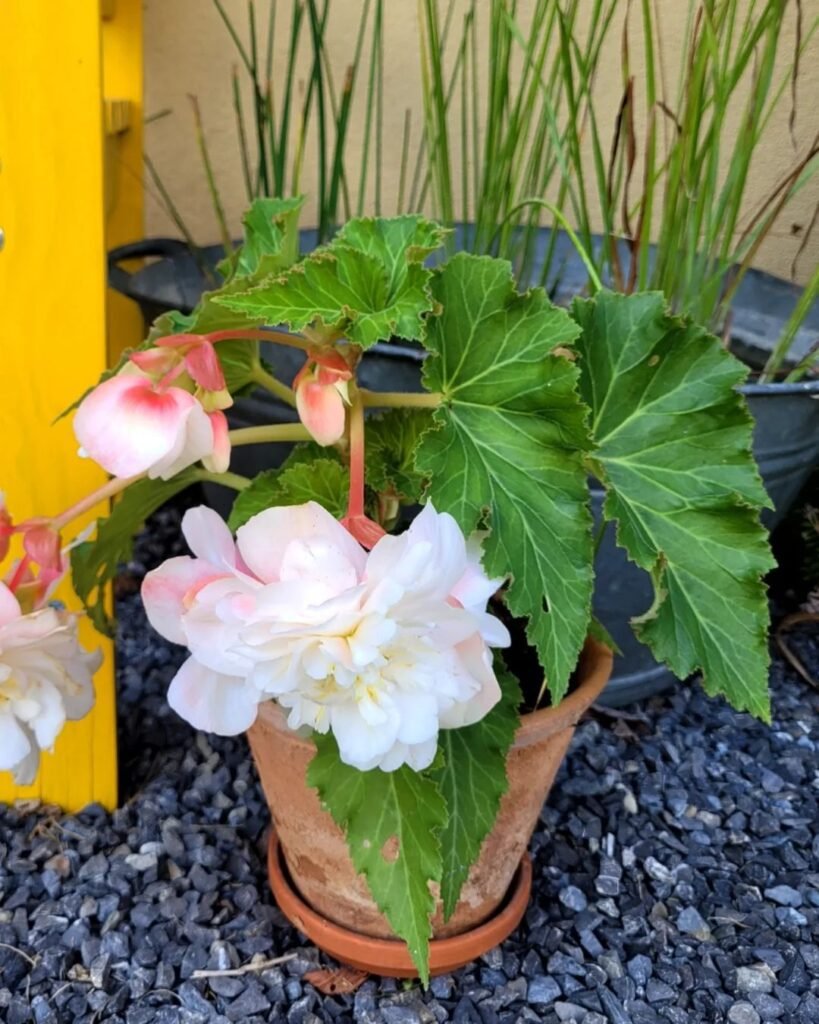
Examining the botanical characteristics of Begonia Angelique reveals distinctive features. The leaves, marked by asymmetry and serrated edges, create a recognizable silhouette with colors ranging from deep forest greens to subtle silver undertones, contributing to an overall visually striking foliage.
The focal point is the cluster of blooms, resembling intricate butterflies. These flowers display a palette dominated by subdued pinks, deep reds, and pristine whites. The petals are arranged to evoke an elegant structure, making each bloom a unique manifestation of an angelic form.
Not the plant for you? Check out my full list of 78 Types of Begonia!
How to Grow Begonia Angelique
Growing a thriving Begonia Angelique demands a thoughtful approach, understanding the nuances that cater to its specific needs. Following a systematic care routine ensures a flourishing plant that graces your space with its angelic blooms.
Watering
When it comes to 💧 watering Begonia Angelique, strike a balance between moisture and moderation. Aim to keep the soil lightly moist but not waterlogged. Allow the top inch of the soil to dry before the next watering session. Consider using a saucer beneath the pot to catch excess water, preventing root rot.
- Proximity Assessment: Gauge the moisture level by inserting your finger into the soil. Water when the top inch feels dry, but avoid letting it completely dry out to prevent stress.
- Water Quality: Use room temperature, filtered water to prevent shock to the plant. Allow water to sit for a day to dissipate chlorine and other potentially harmful chemicals.
- Watering Consistency: Maintain a consistent watering schedule, but be adaptable to seasonal changes. Adjust the frequency based on environmental conditions and the plant’s growth stage.
- Root Consideration: Be mindful of the begonia’s shallow root system. Water at the base of the plant to prevent water from pooling on the leaves, reducing the risk of fungal issues.
Lighting
Provide your Begonia Angelique with the ideal ☀️ lighting conditions for optimal growth. Indirect sunlight works wonders, but shield the plant from harsh midday rays. If it’s an indoor companion, placing it near a bright, filtered window suffices. Should you notice leggy growth, it’s a signal that the plant might be longing for more light.
Soil and Fertilizing
Choose a well-draining 🌱 potting mix to ensure proper aeration for Begonia Angelique’s roots. Fertilize monthly during the growing season, using a balanced liquid fertilizer. However, exercise caution – it’s better to err on the side of less fertilizer than more to avoid potential damage to the delicate roots.
Humidity and Temperature
Maintain a 💦 humid environment by misting the plant regularly, especially during drier periods. Aim for a temperature range between 65°F to 75°F (18°C to 24°C), avoiding sudden fluctuations. If you encounter brown leaf edges, it might signal low humidity or exposure to cold drafts – a gentle misting can help alleviate the issue.
Pruning and Shaping
Elevate the visual allure of your Begonia Angelique by mastering the art of pruning and shaping. To maintain a neat and compact appearance, regularly deadhead spent blooms.
This not only encourages the continuous production of new flowers but also prevents the plant from diverting energy to seed formation. Additionally, if you notice leggy growth, strategically trim the stems to stimulate bushier, more robust foliage.
Pruning Tip: Deadheading is most effective when done by pinching off the spent blooms just above a leaf node, promoting healthy regrowth.
Common Issues



Ensuring the well-being of your Begonia Angelique involves recognizing and addressing common issues that may arise during its care. Keep a vigilant eye for yellowing leaves, a potential signal of overwatering. Should you observe crispy edges on the leaves, it may indicate low humidity levels. Here’s an in-depth guide to troubleshoot and remedy these common concerns:
- Yellowing Leaves:
- Issue: Overwatering.
- Solution: Adjust the watering frequency, allowing the top inch of soil to dry before the next watering.
- Crispy Leaf Edges:
- Issue: Low Humidity.
- Solution: Increase humidity levels by misting the plant regularly or placing a tray of water nearby.
- Leggy Growth:
- Issue: Insufficient Light.
- Solution: Provide more indirect sunlight to encourage compact and bushy growth.
- Brown Spots on Leaves:
- Issue: Pests or Fungal Infections.
- Solution: Inspect the plant for pests and treat accordingly. Consider applying a fungicide if fungal issues persist.
- Slow Growth:
- Issue: Inadequate Nutrition.
- Solution: Evaluate the fertilization regimen, ensuring a balanced approach to support healthy growth.
Seasonal Care Guidelines
Begonia Angelique’s needs evolve with the seasons, and understanding these changes is crucial for sustained health and blooming. Tailor your care routine to accommodate fluctuations in light, temperature, and growth patterns. Here’s a seasonal breakdown to guide you through the nuances of each stage:
| Season | Care Tips |
|---|---|
| Spring | Gradually increase watering as the plant enters its active growth phase. Consider repotting if root-bound. |
| Summer | Provide shade during scorching midday sun, and amp up humidity with regular misting. Adjust fertilization for increased energy demands. |
| Fall | Scale back on watering as growth slows. Prepare the plant for the upcoming dormant period by reducing fertilization. |
| Winter | Maintain a consistent temperature, avoid cold drafts, and decrease watering. Prune sparingly, focusing on removing dead or damaged growth. |
Begonia Angelique’s Dormancy Period
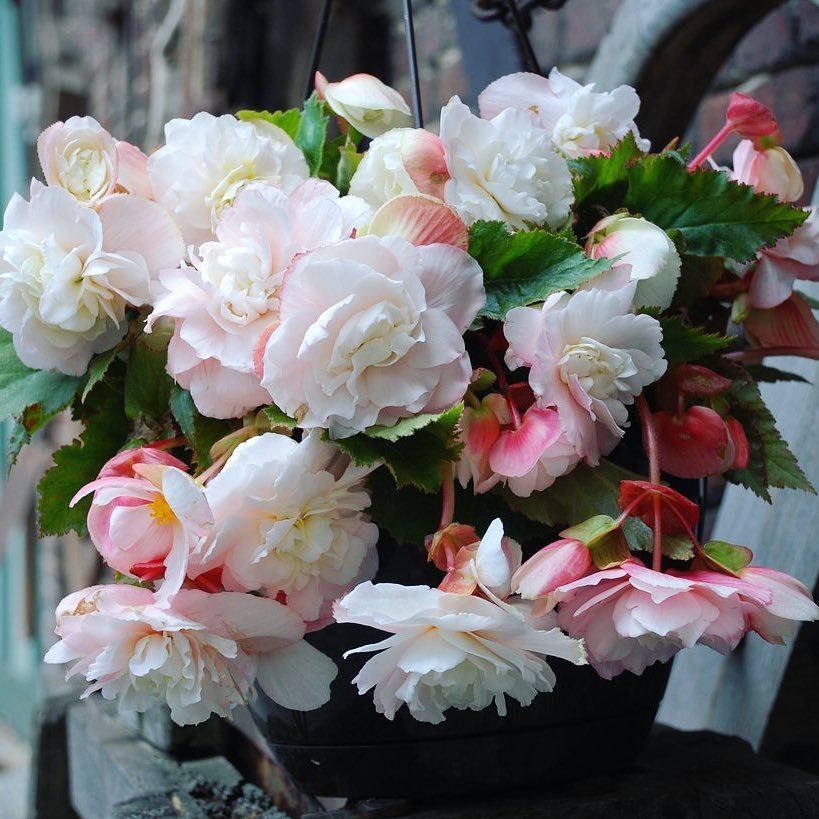
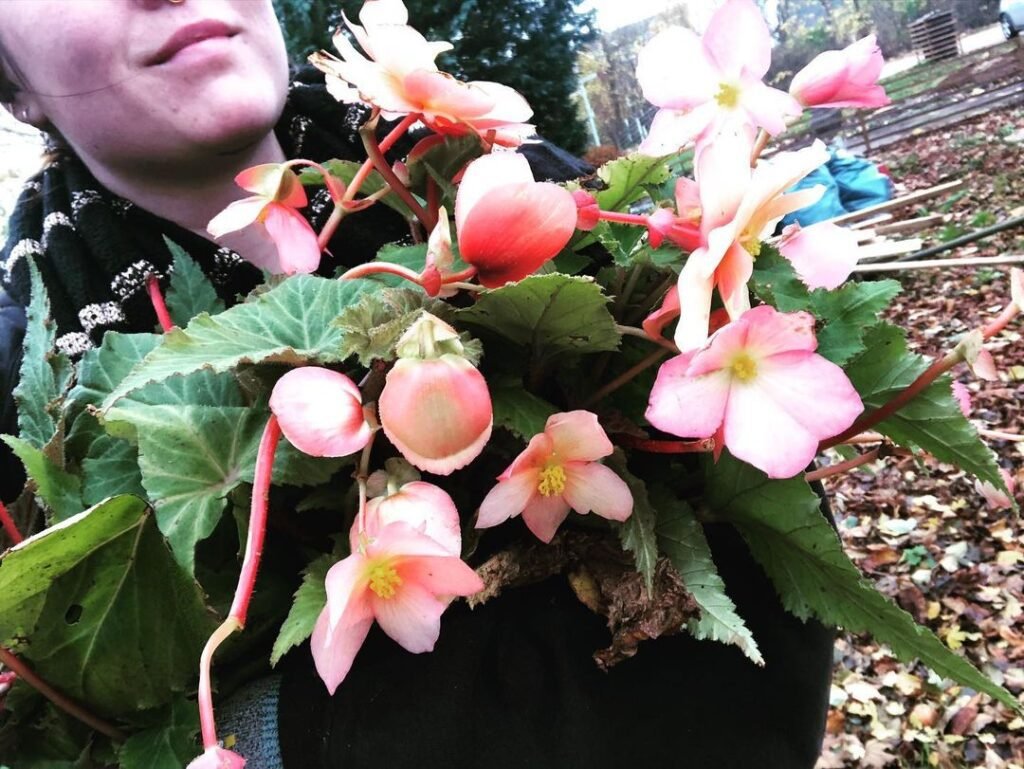

Understanding and respecting the dormant phase of Begonia Angelique is crucial for its overall health and longevity. While the plant may appear less active during this period, specific care considerations ensure a smooth transition and a robust return to growth. Here’s how to navigate the dormancy phase effectively:
- Reduced Watering:
- Scale back on watering as the plant’s growth slows. Allow the top inch of soil to dry out before considering the next watering.
- Temperature Adjustment:
- Maintain a slightly cooler environment during dormancy, ideally around 60°F to 65°F (15°C to 18°C). This mimics the plant’s natural conditions.
- Limited Fertilization:
- Refrain from fertilizing during dormancy. The plant’s reduced metabolic activity doesn’t require the additional nutrients provided by fertilizers.
- Pruning and Grooming:
- Prune sparingly during dormancy, focusing on removing dead or damaged growth. This encourages the plant to direct energy where it’s needed most.
- Observation and Patience:
- Monitor the plant closely for any signs of stress or disease. Be patient; Begonia Angelique’s dormant phase is a natural part of its growth cycle.
Care Tips: Use this period to inspect the plant for pests or diseases and make any necessary adjustments to its care routine. Additionally, resist the urge to force the plant into active growth; instead, allow it to naturally emerge from dormancy when conditions are favorable.
Companion Planting with Begonia Angelique
Unlock the full aesthetic potential of your garden by strategically incorporating Begonia Angelique as a companion plant. Choose plant partners that complement its needs and enhance the overall visual appeal. Here’s a pairing guide to create harmonious and visually stunning combinations:
| Companion Plant | Benefits |
|---|---|
| Ferns | Enhance humidity levels, creating an ideal environment for Begonia Angelique. |
| Impatiens | Similar water and light requirements, making them compatible companions. |
| Hostas | Provide shade and complement Begonia Angelique’s vibrant colors. |
| Coleus | Add a burst of color and thrive in similar growing conditions. |
| Heuchera (Coral Bells) | Offer contrasting foliage shapes and colors for a visually dynamic garden. |
If you’re thinking of extending your begonia family, I recommend considering either begonia aconitifolia or begonia convolvulacea. They both would make great additions to your squad!
Crafting a Begonia Angelique Arrangement
Transform your living space into a botanical masterpiece by harnessing the artistic potential of Begonia Angelique arrangements. Explore various container options, mixing colors and textures for a visually striking display. Consider these tips to create an arrangement that showcases the unique beauty of this begonia:
- Container Selection: Opt for containers with drainage holes to prevent waterlogged soil. Choose vessels that complement the begonia’s colors, providing a harmonious backdrop.
- Color Palette: Play with contrasting and complementary colors to highlight Begonia Angelique’s blooms. Experiment with varying heights to add depth to the arrangement.
- Texture Dynamics: Integrate different foliage textures to create visual interest. Mix Begonia Angelique with plants boasting varied leaf shapes for a well-balanced arrangement.
- Seasonal Accents: Enhance the arrangement’s appeal by incorporating seasonal accents like decorative stones or miniature ornaments, adjusting them as seasons change.
Unlocking the Art of Begonia Angelique Propagation
Expand your collection and share the beauty of Begonia Angelique by delving into the world of propagation. Whether you’re a seasoned plant enthusiast or a beginner, propagation offers a rewarding journey. Here’s a step-by-step guide along with essential care tips:
- Selecting Healthy Cuttings:
- Choose stem cuttings with at least two nodes, ensuring they are free from diseases or pests.
- Opt for cuttings taken during the plant’s active growth period for higher success rates.
- Rooting Medium and Environment:
- Use a well-draining rooting medium, such as a mix of perlite and peat moss.
- Maintain high humidity by covering the cuttings with a plastic dome or placing them in a plastic bag until roots develop.
- Rooting Hormone Application:
- Dip the cut ends in rooting hormone before planting to stimulate root development.
- Shake off excess powder to avoid overapplication, which can hinder rather than promote rooting.
- Temperature and Light Conditions:
- Keep the rooting environment consistently warm, ideally between 70°F to 75°F (21°C to 24°C).
- Provide indirect light to the cuttings to encourage root growth without exposing them to harsh sunlight.
- Transplanting Young Plants:
- Once the cuttings have developed sufficient roots, carefully transplant them into individual pots with well-draining soil.
- Gradually acclimate the young plants to their new environment before placing them in their permanent homes.
Care Tips: Monitor humidity levels closely during the propagation process, as Begonia Angelique cuttings thrive in a high-humidity environment. Additionally, be patient; propagation may take several weeks, but the reward is well worth the wait.
Conclusion
In the fascinating journey of cultivating Begonia Angelique, one discovers a world where care becomes an art form and the plant itself is a canvas of natural beauty. From the delicate blooms that mimic fluttering butterflies to the intricate details of its foliage, this begonia captivates the hearts of both seasoned plant enthusiasts and those just beginning their botanical ventures.
Remember, success in growing Begonia Angelique lies in a thoughtful combination of understanding its specific needs, providing the right environment, and embracing the joy that comes with nurturing a living work of art. As you continue on this botanical adventure, may your Begonia Angelique flourish, bringing continuous blooms and a touch of enchantment to your green space.
FAQs
Can Begonia Angelique tolerate direct sunlight?
Begonia Angelique prefers bright, indirect light. While it can tolerate some morning sun, it’s essential to protect it from harsh midday rays, which can lead to leaf scorching.
How often should I fertilize Begonia Angelique?
Fertilize Begonia Angelique monthly during the growing season (spring and summer). However, it’s crucial to strike a balance, as over-fertilization can harm the delicate roots.
Is Begonia Angelique suitable for indoor gardens?
Absolutely! Begonia Angelique is a versatile plant that adapts well to indoor environments. Ensure it receives bright, filtered light and maintain proper humidity levels.
Why are the leaves of my Begonia Angelique turning yellow?
Yellowing leaves may indicate overwatering. Adjust your watering routine, allowing the top inch of soil to dry out before the next watering session.
Can I propagate Begonia Angelique in water?
While Begonia Angelique can be propagated in water, it’s generally more successful using a well-draining rooting medium, such as a mix of perlite and peat moss.

Writer/Green Thumb/Explorer – Rooted deep in the rich soils of Devon, I’ve cultivated a vast expertise in plant care, helping greenery thrive in homes across the UK. When I’m not crafting detailed plant care guides, I’m journeying through the lush landscapes of the West Country, unearthing nature’s secrets and sharing them with fellow plant enthusiasts. Every leaf has a story, and I’m here to tell it.





